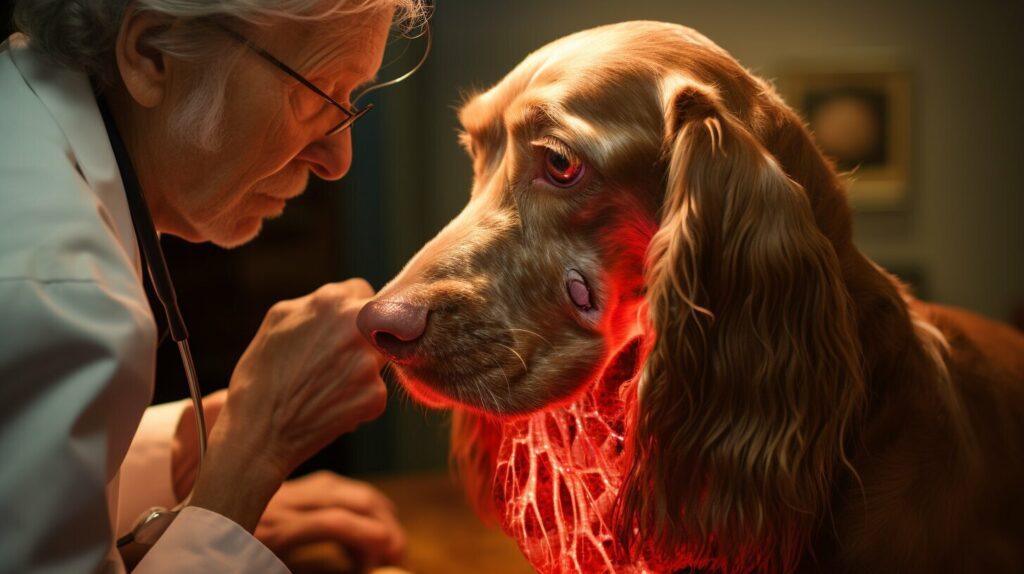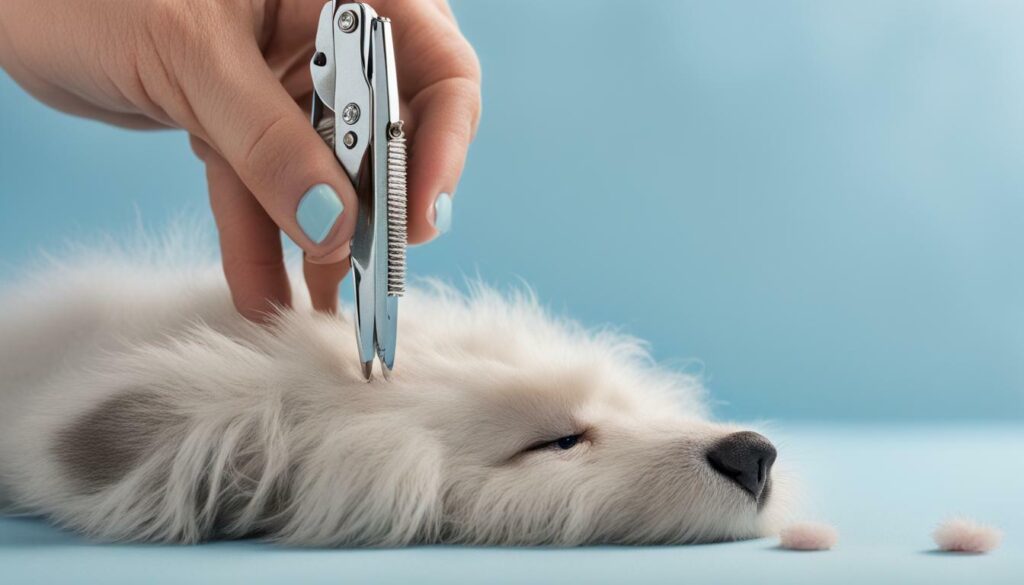If you are a dog owner, it is important to be aware of mastitis, a common health condition that can affect your pet. Mastitis is an inflammation of the mammary gland tissue that can occur in both nursing and non-nursing female dogs, as well as in male dogs. It is caused by bacterial infections and blocked milk ducts, and it can lead to serious complications if left untreated.
Key Takeaways:
- Mastitis is an inflammation of the mammary gland tissue in dogs
- It can be caused by bacterial infections and blocked milk ducts
- Mastitis can occur in both nursing and non-nursing female dogs as well as male dogs
- Prompt treatment is essential to avoid complications
What is Mastitis in Dogs?
If you’re a dog owner, it’s essential to understand what mastitis is, how it affects dogs, and its potential complications. Mastitis refers to the inflammation of mammary tissue, which can be caused by bacterial infections or blocked milk ducts. Common causes of mastitis in dogs include poor hygiene, trauma to the mammary glands, and hormonal imbalances.
Dogs that are nursing are particularly susceptible to mastitis, as their nipples and mammary glands are exposed to bacteria during nursing. However, non-nursing female dogs and even male dogs can also develop mastitis, albeit less frequently.
To reduce the risk of mastitis in your dog, it’s crucial to practice proper hygiene and nursing techniques. Regularly cleaning the mammary glands and ensuring your dog has a balanced diet can also help reduce the risk of mastitis.
Causes of Mastitis in Dogs
Mastitis in dogs can be caused by a variety of factors, including bacterial infection, poor hygiene, and blocked milk ducts. Bacterial infections are the primary cause of mastitis in nursing dogs, with Staphylococcus aureus being the most common infection. Poor hygiene practices, such as infrequent cleaning of the mammary glands, can also lead to mastitis by allowing bacteria to accumulate and grow. Blockage of milk ducts can also cause mastitis, as it prevents milk from being properly expressed and can lead to inflammation and infection.
Hormonal imbalances can also increase the risk of mastitis in dogs, particularly in non-nursing female dogs. This can be caused by underlying medical conditions or the administration of certain medications. Trauma to the mammary glands, such as injuries from fights or falls, can also lead to mastitis.
Risk Factors for Mastitis in Dogs
Some dogs may be at a higher risk of developing mastitis than others. Older dogs, overweight dogs, and dogs with preexisting medical conditions may be more susceptible to mastitis. Dogs that have recently given birth or are nursing puppies are also at a higher risk for developing mastitis, particularly if proper hygiene practices are not followed.
It’s essential to be aware of your dog’s risk factors and take steps to reduce the likelihood of mastitis.
Signs and Symptoms of Mastitis in Dogs
Mastitis in dogs is a serious condition that can affect nursing mothers and non-nursing females alike. Knowing the signs and symptoms of mastitis in dogs is essential for early identification and prompt treatment. Here are some common signs to look out for:
- Swollen mammary glands: When a dog’s mammary glands are swollen and firm to the touch, it may indicate mastitis.
- Redness and warmth: Affected mammary glands may be red, inflamed, and warm to the touch.
- Pain or discomfort: Dogs with mastitis may experience pain or discomfort when nursing or when their mammary glands are touched or manipulated.
- Abnormal milk: The milk from affected mammary glands may be discolored, thick, or contain pus.
- Behavioral changes: Dogs may exhibit changes in behavior, such as decreased appetite, lethargy, or aggression when approached.
If you notice any of these signs and suspect that your dog may have mastitis, it is important to seek veterinary care immediately. Early diagnosis and treatment are crucial for a positive outcome.
Diagnosing Mastitis in Dogs
If you suspect that your dog has mastitis, it’s crucial to seek veterinary care as soon as possible. A prompt diagnosis and treatment can prevent the condition from worsening and causing potentially serious complications.
Your vet will perform a physical examination of your dog, paying close attention to the mammary glands and any signs of swelling or redness. Your vet may also recommend laboratory tests, such as a bacterial culture or bloodwork, to determine if there is an underlying bacterial infection causing the mastitis.
If your dog is diagnosed with mastitis, your vet will likely prescribe antibiotics to combat the bacterial infection. Pain management is also an essential part of the treatment plan, as mastitis can be very painful for your dog. In severe cases, hospitalization may be necessary to provide intravenous antibiotics and fluids.
It’s essential to follow your vet’s treatment plan carefully and administer any prescribed medications as directed. Failure to do so can lead to the recurrence of mastitis or the development of more severe complications such as sepsis.
Treating Mastitis in Dogs
If your dog has been diagnosed with mastitis, it is important to begin treatment as soon as possible. Treatment typically involves a combination of antibiotics and supportive care.
Antibiotics: Your veterinarian may prescribe antibiotics to combat the bacterial infection that is causing the mastitis. These medications should be administered as directed by your veterinarian, even if your dog appears to be feeling better before the full course of antibiotics is complete.
Pain management: Mastitis can be very painful for your dog. Your veterinarian may recommend pain medication to make your dog more comfortable during the recovery period.
| Supportive care: | Why it’s important: |
|---|---|
| Frequent nursing: | Emptying the mammary glands frequently can help to reduce inflammation and speed up the healing process. |
| Warm compresses: | Applying a warm compress to the affected area can help to increase blood flow and reduce discomfort. |
| Hygiene: | Keeping the affected area clean and dry can help to prevent further infection. |
It is important to follow your veterinarian’s instructions closely and to monitor your dog closely for any changes in behavior or symptoms. If your dog’s condition worsens or does not improve with treatment, contact your veterinarian immediately.
Additionally, ensure your dog is receiving a balanced diet to promote overall health and aid in their recovery from mastitis.
Preventing Mastitis in Dogs
Mastitis in dogs can be a painful and potentially dangerous condition, but there are steps you can take to reduce the risk of it occurring in your pet. By following proper hygiene practices and monitoring your dog’s health, you can help prevent mastitis from developing.
Mastitis causes in dogs can include bacterial infections, blocked milk ducts, and poor nursing hygiene. To prevent this condition, it is important to maintain a clean and healthy environment for your dog.
Here are some tips for preventing mastitis in your dog:
- Regularly clean and disinfect your dog’s living space, including its bed, toys, and food/water bowls.
- Practice good nursing hygiene if your dog is nursing, including washing your hands before handling the puppies and cleaning the mammary glands regularly.
- Feed your dog a balanced diet with proper nutrition to promote overall health and a strong immune system.
- Monitor your dog’s mammary glands and overall health regularly for any signs of infection or other abnormalities.
If you suspect your dog may have mastitis, it is important to seek veterinary care promptly. Early detection and treatment can help prevent complications and promote a speedy recovery for your pet.
When to Seek Veterinary Care
If you suspect that your dog may be suffering from mastitis, it’s essential to seek veterinary care as soon as possible. Early detection and prompt treatment are critical to ensuring a full recovery for your pet.
If your dog is exhibiting any of the symptoms of mastitis, such as swollen mammary glands, redness, warmth, or behavioral changes, it’s important to schedule an appointment with your veterinarian right away.
In some cases, mastitis can lead to serious complications, such as sepsis or even death, so it’s crucial to seek veterinary care promptly. Your veterinarian will be able to perform a physical examination and diagnostic tests to determine the cause of your dog’s symptoms and develop a treatment plan to address them.
Remember, your dog’s health is your responsibility. By staying vigilant and seeking veterinary care promptly, you can help ensure that your pet stays healthy and happy for years to come.
Supporting Your Dog’s Recovery
If your dog has been diagnosed with mastitis, it is crucial to follow the treatment plan prescribed by your veterinarian. In addition to antibiotics and pain management, there are several things you can do to support your dog’s recovery:
- Provide a clean and comfortable environment: Mastitis can be very painful for dogs, especially when nursing. Make sure your dog has a clean and comfortable area to rest and recover.
- Practice proper wound care: If your dog has any open wounds from mastitis, be sure to clean them regularly and apply any prescribed ointments or dressings. This will help prevent infection and promote healing.
- Monitor for recurrence of symptoms: Even after treatment, it’s important to keep an eye on your dog for any signs of mastitis. If you notice any recurring symptoms, contact your veterinarian immediately.
- Follow-up veterinary care: Your veterinarian may recommend follow-up appointments to monitor your dog’s progress and ensure that mastitis has been fully resolved. Be sure to make all recommended appointments.
Remember, mastitis can be a serious and potentially life-threatening condition if left untreated. By following your veterinarian’s treatment plan and providing support and care for your dog’s recovery, you can help ensure a successful outcome.
Mastitis in Non-Nursing Female Dogs and Male Dogs
Mastitis can occur in non-nursing female dogs and male dogs, although it is less common than in nursing females. Non-nursing female dogs may develop mastitis as a result of a bacterial infection, trauma or inflammation in the mammary gland area. Male dogs may develop mastitis due to an underlying health condition such as kidney disease or a weakened immune system.
The symptoms and treatment for mastitis in non-nursing female dogs and male dogs are similar to those in nursing females. Swelling, redness, tenderness, and discharge from the nipples are common symptoms. Treatment options may include antibiotics, pain management, and supportive care. In severe cases, surgery may be necessary.
If you notice any symptoms of mastitis in your non-nursing female dog or male dog, it is essential to seek veterinary care as soon as possible. Early treatment can help prevent complications and ensure a faster recovery.
Conclusion
Understanding mastitis in dogs is crucial for every dog owner. This article provided a comprehensive guide on identifying and treating mastitis in dogs. By recognizing the signs and symptoms of mastitis and seeking veterinary care promptly, you can ensure that your dog receives the appropriate treatment and prevent any complications.
Remember to practice good hygiene and proper nursing techniques to prevent the development of mastitis. Maintaining a balanced diet and providing supportive care can also promote overall health and reduce the likelihood of mastitis.
If you suspect that your dog may have mastitis, do not hesitate to seek veterinary care. Early treatment is key to a successful recovery. Schedule a check-up with your veterinarian and provide a nurturing environment for your dog’s recovery.
FAQ
Q: What is mastitis in dogs?
A: Mastitis in dogs is an inflammation and infection of the mammary glands. It can occur in both nursing and non-nursing dogs.
Q: What are the signs and symptoms of mastitis in dogs?
A: Signs of mastitis in dogs include swollen and painful mammary glands, redness, warmth, and behavioral changes such as decreased appetite and lethargy.
Q: How is mastitis in dogs diagnosed?
A: Mastitis in dogs is diagnosed through a physical examination by a veterinarian and may involve laboratory tests such as a bacterial culture of the milk.
Q: How is mastitis in dogs treated?
A: Treatment for mastitis in dogs involves antibiotics to combat the infection, pain management, and supportive care such as maintaining proper hygiene and nutrition.
Q: How can mastitis in dogs be prevented?
A: Mastitis in dogs can be prevented by practicing good hygiene, proper nursing techniques, and monitoring for signs of infection. A balanced diet is also important for preventing mastitis.
Q: When should I seek veterinary care for mastitis in my dog?
A: It is important to seek veterinary care for mastitis in your dog as soon as you notice any signs or symptoms. Early detection and treatment can help prevent complications.
Q: How can I support my dog’s recovery from mastitis?
A: Supporting your dog’s recovery from mastitis includes proper wound care, pain management, and monitoring for any recurrence of symptoms. Follow-up veterinary care is also important.
Q: Can mastitis occur in non-nursing female dogs and male dogs?
A: Yes, mastitis can occur in non-nursing female dogs and male dogs. The causes and treatment options may differ from those in nursing dogs.



